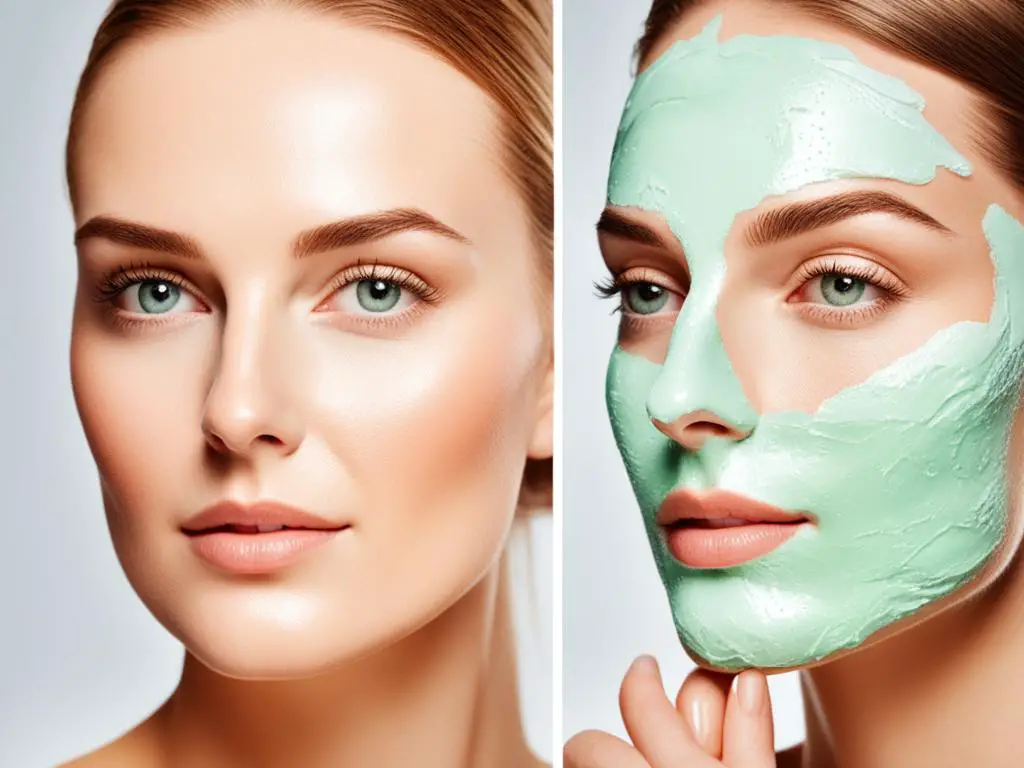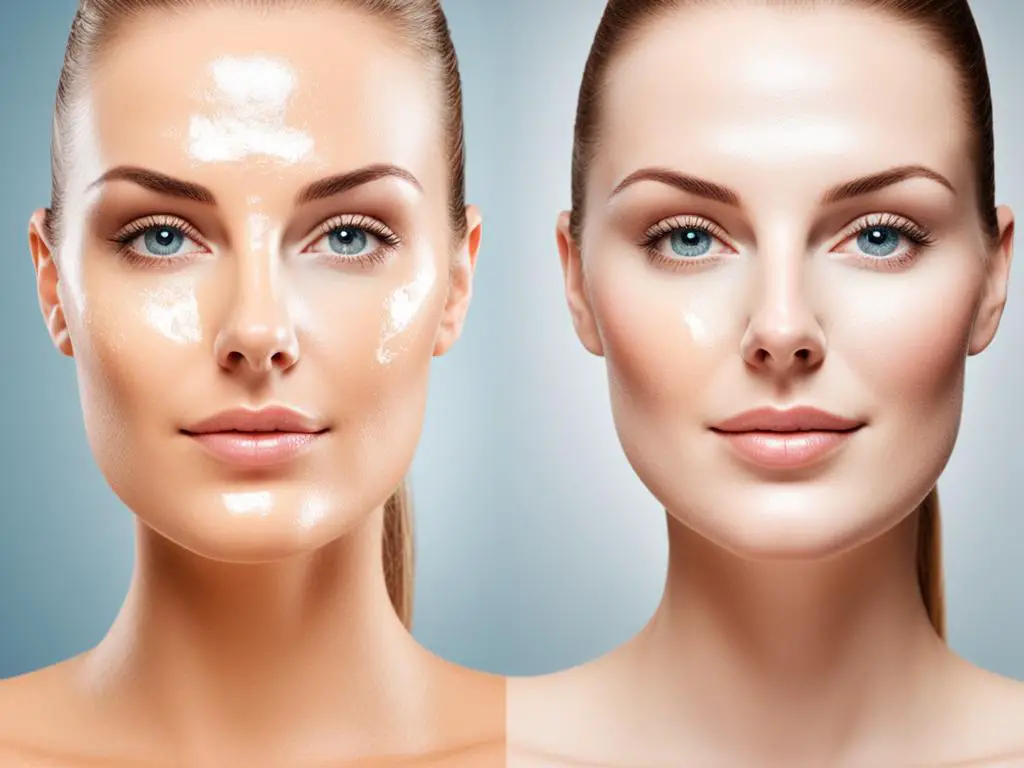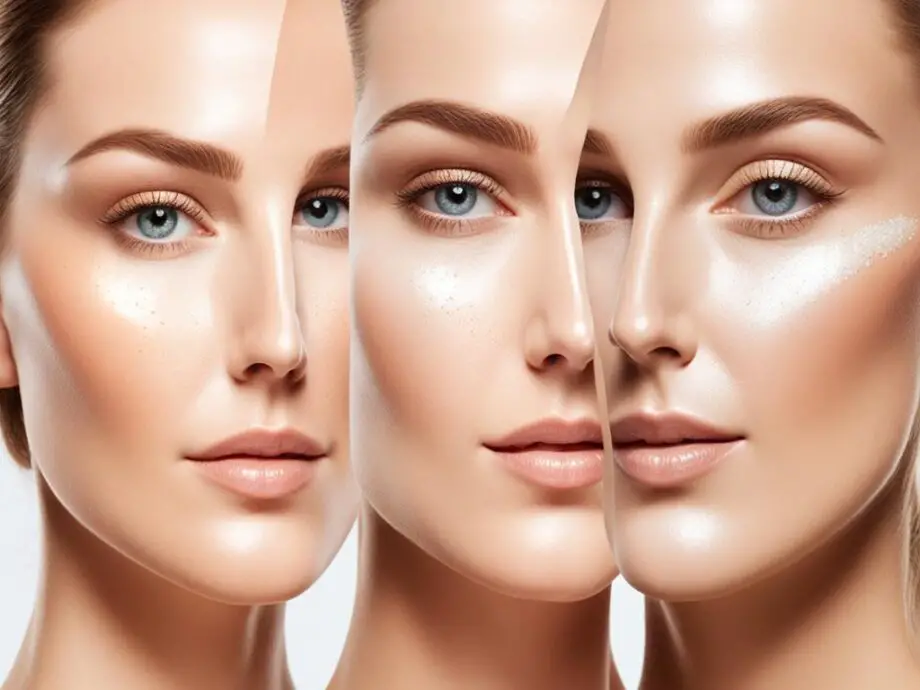Welcome to our in-depth guide on achieving a healthy, radiant complexion. In this article, we will explore the difference between oily and glowy skin types and provide you with valuable tips on how to achieve your healthiest shine. Whether you’re dealing with excessive oiliness or looking to attain a natural, luminous glow, we’ve got you covered.
Many people often confuse oily skin with a glowy complexion, but they are not the same. Oily skin tends to produce excess sebum, leading to a shiny appearance that can be challenging to manage. On the other hand, a glowy complexion is all about achieving a healthy, luminous radiance that exudes vitality and youthfulness.
Key Takeaways:
- Oily skin and a glowy complexion are two distinct skin conditions.
- Understanding the differences can help you choose the right skincare routine.
- Managing oiliness and achieving a natural glow are both possible.
- There are specific remedies and products available for oily skin.
- Identifying your skin type is crucial for tailoring the right skincare routine.
Understanding Oily Skin
Having oily skin can be frustrating, but with the right knowledge and skincare routine, managing oil production and achieving a healthy complexion is possible. In this section, we will explore the characteristics of oily skin, discuss common skincare issues faced by those with oily skin, and provide practical tips on how to manage and balance oil production.
The Characteristics of Oily Skin
Oily skin is characterized by an overproduction of sebum, the natural oil produced by the skin. This excess oil can leave the skin looking shiny and greasy, and it may be prone to clogged pores, blackheads, and acne breakouts. People with oily skin typically have larger pores and may experience a constant feeling of oiliness throughout the day.
Common Skincare Issues for Oily Skin
Those with oily skin often struggle with skincare issues such as acne, enlarged pores, and uneven skin texture. The excessive oil production can create a breeding ground for bacteria, leading to frequent breakouts. Additionally, the enlarged pores can become clogged with dirt, dead skin cells, and excess oil, resulting in blackheads and whiteheads.
Tips for Managing Oily Skin
- Use a gentle cleanser formulated specifically for oily skin to remove excess oil and impurities without stripping the skin.
- Avoid using harsh scrubs or abrasive cleansers, as they can overstimulate oil production.
- Keep your skin hydrated by using an oil-free moisturizer. Contrary to popular belief, moisturizing oily skin is essential to maintain a healthy skin barrier.
- Exfoliate regularly to remove dead skin cells and unclog pores. Look for gentle exfoliants with ingredients like salicylic acid or glycolic acid.
- Use products that contain ingredients like niacinamide, tea tree oil, or witch hazel, as they can help regulate oil production and reduce shine.
- When applying makeup, choose oil-free or non-comedogenic products that won’t clog your pores.
- Avoid touching your face throughout the day, as it can transfer oil, bacteria, and dirt from your hands to your skin.
By following these tips and establishing a consistent skincare routine, you can effectively manage oily skin and achieve a healthier, more balanced complexion.

Stay tuned for the next section where we will share the steps and products needed to achieve a natural, healthy glowy complexion.
Achieving a Glowy Complexion
When it comes to skincare, achieving a glowy complexion is often the ultimate goal. A healthy, radiant glow can instantly elevate your look and boost your confidence. However, achieving that dewy, luminous skin requires more than just wishful thinking. It requires a dedicated skincare routine and the right products to nourish and hydrate your skin.
If you’re wondering how to get glowy skin, look no further. We’ve curated a step-by-step skincare routine that will help you achieve that coveted glow. Whether you have dry skin, combination skin, or oily skin, these tips and techniques will help you unlock your skin’s natural luminosity.
Cleansing and Exfoliating
Start your skincare routine with a gentle cleanser that suits your skin type. Cleansing removes dirt, oil, and impurities, allowing your skin to breathe and absorb products better. Opt for cleansers that are hydrating and non-stripping to maintain your skin’s natural moisture barrier.
Exfoliation is a crucial step in achieving a glowy complexion. By sloughing off dead skin cells, you’ll reveal a fresh, radiant layer of skin. Choose a chemical exfoliant with ingredients like glycolic acid or lactic acid for gentle yet effective exfoliation. This will help improve skin texture and promote a healthy glow.
Hydration and Moisturization
Hydration is key to achieving dewy skin. Incorporate a hydrating toner or essence into your skincare routine to replenish moisture and plump up your skin. Look for ingredients like hyaluronic acid or glycerin, which attract and retain moisture.
Leverage the power of serums to address specific skin concerns and amp up your glow factor. Vitamin C serums can help brighten the skin and fade dark spots, while hyaluronic acid serums provide intense hydration.
Seal in all that hydration with a moisturizer that suits your skin type. Choose lightweight formulas for oily skin and richer creams for drier skin. Look for moisturizers with ingredients like ceramides and niacinamide to strengthen the skin barrier and improve skin texture.
Sun Protection
Protecting your skin from the sun is crucial in maintaining a healthy glow. Exposure to harmful UV rays can lead to premature aging and dullness. Incorporate a broad-spectrum sunscreen with at least SPF 30 into your daily skincare routine, even on cloudy days. Opt for lightweight, non-comedogenic formulas to avoid clogging your pores.
Incorporate Dewy Makeup Techniques
To enhance your glowy complexion, consider incorporating dewy makeup techniques. Use a luminous primer or a light-reflecting foundation to give your skin a radiant finish. Highlighter can be your best friend when it comes to achieving that lit-from-within glow. Apply it to the high points of your face, such as the cheekbones, brow bone, and cupid’s bow, for an instant radiant boost.

Oily Skin Remedies
If you struggle with oily skin, don’t fret! There are several natural and dermatologist-recommended remedies that can help control oil production and reduce shine. By incorporating these remedies into your skincare routine, you can achieve a healthier, more balanced complexion.
1. Tea Tree Oil
Tea tree oil is a powerful natural ingredient known for its antimicrobial properties. It can help regulate oil production and reduce acne breakouts associated with oily skin. Mix a few drops of tea tree oil with a carrier oil, such as jojoba or almond oil, and apply it to your face using a cotton pad.
2. Clay Masks
Clay masks are highly effective in absorbing excess oil and unclogging pores. Look for masks containing ingredients like bentonite or kaolin clay. Apply the mask to your face, let it dry, and then rinse it off with warm water. Use a clay mask once or twice a week to keep your skin balanced and mattified.
3. Oil-Free Moisturizers
While it may seem counterintuitive, moisturizing is essential for oily skin. Opt for lightweight, oil-free moisturizers that won’t clog your pores or add extra shine. Look for ingredients like hyaluronic acid or glycerin, which hydrate the skin without leaving a greasy residue.
4. Salicylic Acid
Salicylic acid is a beta hydroxy acid that helps exfoliate the skin and control oil production. Look for cleansers or spot treatments containing salicylic acid to target oily areas and prevent breakouts. However, be cautious not to overuse salicylic acid, as it may cause dryness or irritation.
5. Blotting Papers
Keep a pack of oil-absorbing blotting papers in your purse or pocket for quick touch-ups throughout the day. These thin sheets help remove excess oil without disrupting your makeup. Gently press a blotting paper on oily areas to absorb the shine, leaving your skin looking fresh and matte.
Expert Tip: Combine blotting papers with a mattifying powder for even better results. Lightly dust the powder over your face to further reduce shine and set your makeup.
6. Balanced Diet and Hydration
Remember, a healthy complexion starts from within. Maintain a balanced diet rich in fruits, vegetables, and lean proteins to support overall skin health. Additionally, drink plenty of water throughout the day to stay hydrated and flush out toxins.
By incorporating these oily skin remedies into your skincare routine and following a holistic approach to wellness, you can effectively manage oil production and enjoy a shine-free, healthy glow.
Oily Skin vs Combination Skin: Understanding the Differences
When it comes to skincare, understanding your skin type is crucial for developing an effective routine. Two common skin types that often get confused are oily skin and combination skin. While both types share similarities in oil production, they have distinct characteristics that require different approaches to care.
Oily skin is characterized by excessive sebum production, resulting in a shiny appearance and a predisposition to blemishes and acne. Those with oily skin often struggle with managing shine throughout the day and may experience clogged pores and blackheads.
Combination skin, on the other hand, is a combination of oily and dry or normal areas. Typically, the T-zone (forehead, nose, and chin) tends to be oily, while the cheeks are normal or dry. It can be a bit challenging to find the right balance when you have combination skin, as you need to address both the oily and dry areas.
Identifying Your Skin Type
A key step in caring for your skin is correctly identifying your skin type. Here are some signs that can help you determine whether you have oily or combination skin:
- Oily Skin:
- Excessive shine throughout the day
- Persistent acne or frequent breakouts
- Visible, enlarged pores
- Combination Skin:
- Oily T-zone (forehead, nose, and chin)
- Normal or dry cheeks
- Possible presence of blackheads
Skincare Routines for Oily Skin vs Combination Skin
Once you’ve determined your skin type, it’s crucial to tailor your skincare routine accordingly. Here are some general tips for caring for oily and combination skin:
| Oily Skin | Combination Skin |
|---|---|
| Use a gentle cleanser twice a day to remove excess oil without stripping the skin. | Similarly, use a mild cleanser but focus on the T-zone while being gentle on the dry areas. |
| Look for oil-free, lightweight moisturizers to hydrate the skin without adding extra shine. | Use a dual moisturizer approach: a lightweight, oil-free moisturizer for the T-zone and a richer, hydrating moisturizer for the cheeks. |
| Avoid heavy, thick creams and instead opt for gel-based or water-based skincare products. | Apply a mattifying or oil-control primer on the T-zone to help control shine throughout the day. |
| Use a weekly exfoliating treatment to remove dead skin cells and unclog pores. | Exfoliate regularly to minimize blackheads in the T-zone while being cautious not to over-exfoliate the dry areas. |
Remember, everyone’s skin is unique, and finding the right skincare routine may require some trial and error. Pay attention to how your skin responds to different products and make adjustments as needed. By understanding the differences between oily and combination skin, you can develop a targeted skincare routine that helps you achieve a healthy, balanced complexion.

In the next section, we’ll delve into effective remedies for oily skin, exploring natural and dermatologist-recommended solutions that can help you better manage oil production and maintain a shine-free complexion.
Conclusion
Throughout this article, we have explored the differences between oily and glowy skin types. We have discussed the characteristics of oily skin, the steps to achieve a radiant and glowy complexion, and the remedies to manage excessive oil production. It is important to find a balance that allows your skin to maintain its natural shine while keeping oiliness under control.
To manage oily skin effectively, incorporate a skincare routine specifically tailored to your needs. Cleanse your skin with gentle, oil-free products to remove excess sebum without stripping away essential moisture. Use lightweight, hydrating moisturizers and sunscreen with a non-comedogenic formula to protect your skin without clogging pores. Look for ingredients like salicylic acid or tea tree oil that can help regulate oil production and prevent breakouts.
For a healthy glowy complexion, focus on hydration and nourishment. Add products like serums or facial oils with ingredients like hyaluronic acid or vitamin C to enhance hydration and promote a radiant glow. Incorporate exfoliation into your routine to remove dead skin cells and reveal a fresh, luminous complexion. Finally, embrace makeup techniques like applying highlighter to the high points of your face to enhance your glow.
Remember, achieving your healthiest shine is a journey that requires patience and experimentation. Listen to your skin, adjust your routines accordingly, and seek professional guidance if needed. By understanding and embracing the unique needs of your skin, you can achieve a perfect balance between oiliness and radiance, resulting in a healthy and glowing complexion.
